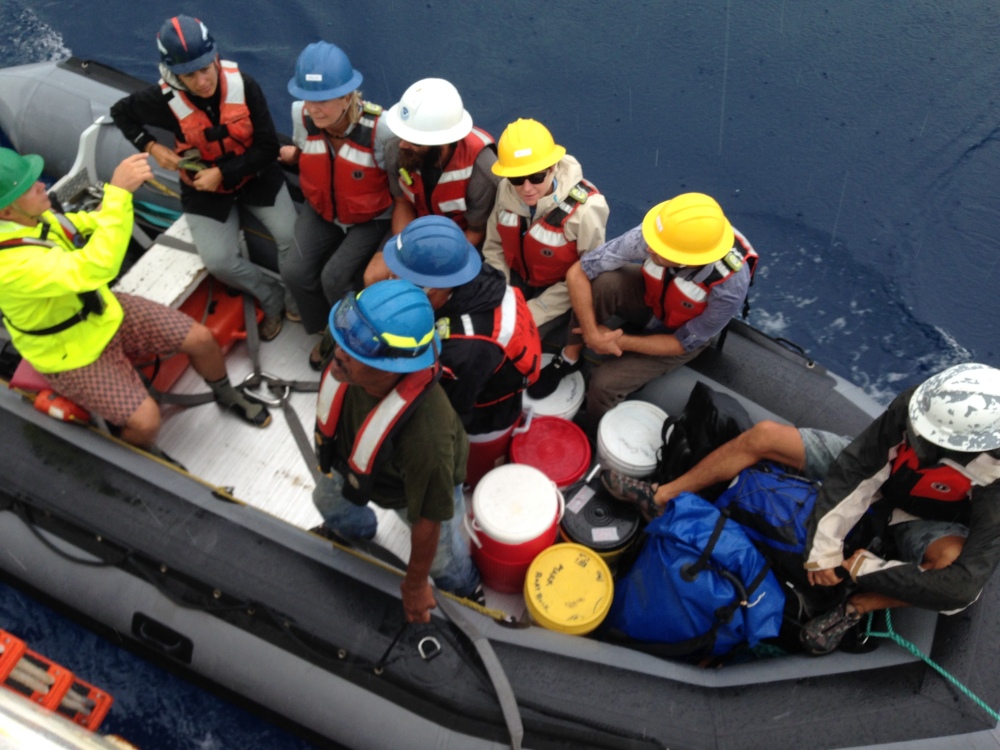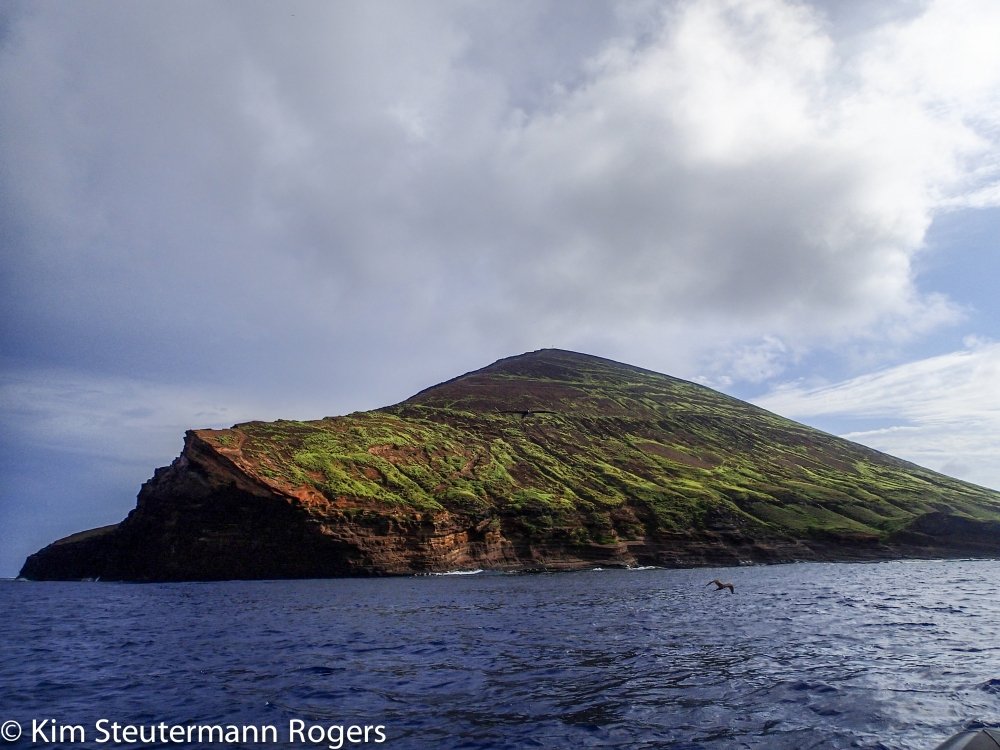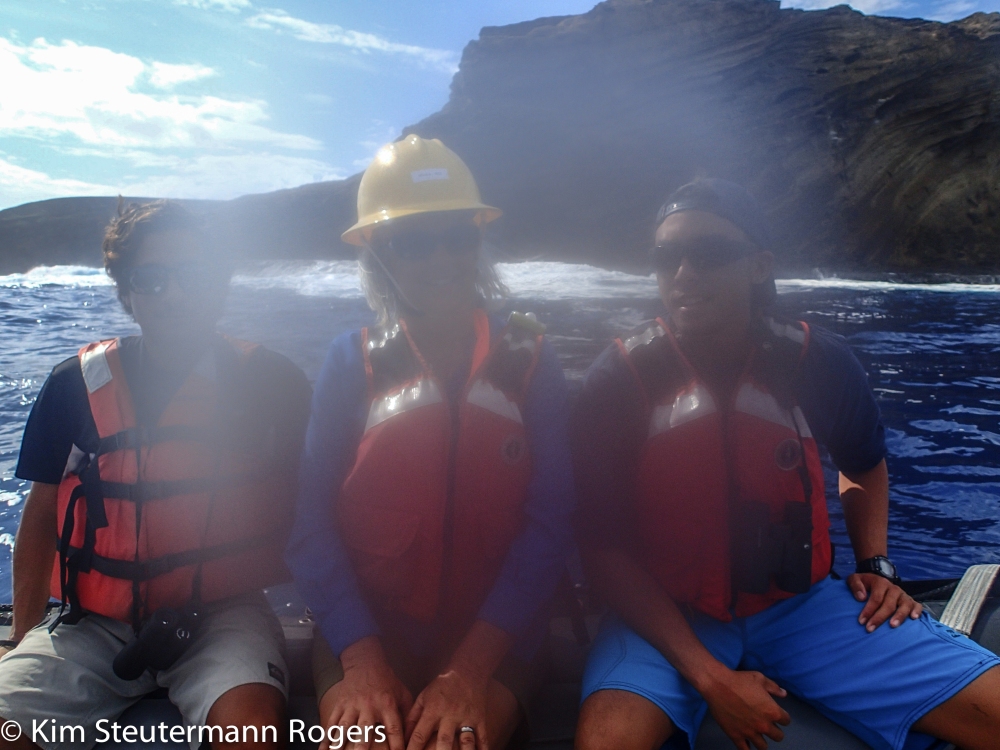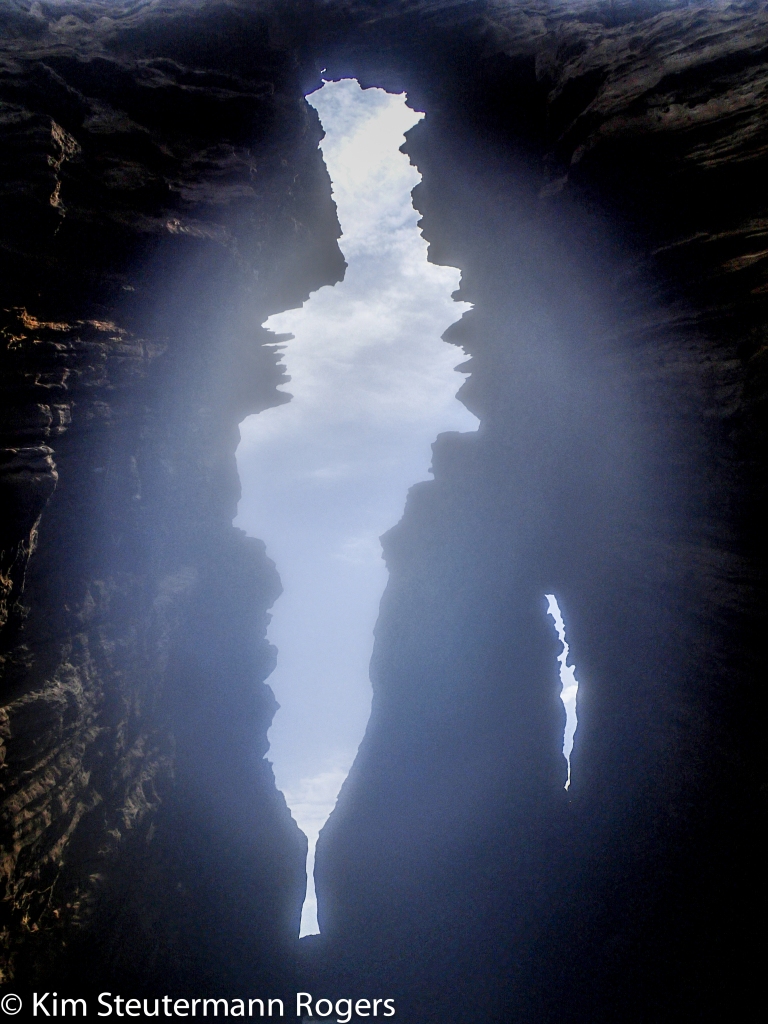We woke to grey skies and a view of the island of Ni`ihau from three miles off shore. Two bottlenose dolphins porpoised off the starboard side of the Oscar Elton Sette while a few inquisitive juvenile brown boobies flew out to investigate us.
A gentle rain started right as we launched our first mission of the trip: Surveying monk seals on the islands of Ni`ihau and Lehua.
Maybe the rain will cool things off, I thought. The summer of 2015 turned out to be one of the hottest on record in Hawai‘i. Five hurricanes in five weeks didn’t help. Those storms sucked up our trade winds and dropped a bonus gift on the islands: Humidity as thick as the dense, neoprene Gumby survival suits we donned in under a minute during yesterday’s safety drills.
The islands of Ni`ihau and Lehua sit approximately 17 miles off the southwest coast of Kaua‘i and are stacked like a semi-colon with the northernmost dot Lehua, and the comma-shaped island Ni`ihau.

“Commit to the boat,” our small boat captain advised, as team members descended a rope ladder some 15 feet down the side of the big, white boat and into an inflatable raft, the SE2, that would shuttle our teams to and from land. The trick was timing the undulating movement of the ocean to gracefully enter the SE2 and not get stuck in the splits with one leg on the ladder and the other on SE2. Eight members of our science crew successfully committed to the SE2 and disembarked the ship for Ni`ihau.
Six miles wide by 18 miles long, Ni`ihau sits in the rain shadow of Kaua‘i and is, thus, quite arid. Its highest elevation is just 1,280 feet above sea level. Elizabeth Sinclair purchased the 72-square-mile island in 1864 from King Kamehameha for $10,000.
Handed down through the generations, the island is owned today by Keith and Bruce Robinson. Approximately 130 Hawaiians live on the island. Their primary language is Hawaiian, and they largely support themselves by subsistence fishing and farming. There are no cell phone towers. In fact, there are no telephones whatsoever. Residents rely on horses as their main form of transportation, and the sun for electricity. With no plumbing or running water, Ni`ihau truly is a place where time stands still.
While the human population of Ni`ihau has dwindled over the generations, that of Hawaiian monk seals has thrived. It’s only recently that NOAA received the necessary approvals to send a team of scientists on-shore to survey the island’s seals. More than count the seals, the team’s objective was to put together a photo identification database. That way, scientists will get a better idea of how far and wide monk seals range, providing an indication of how they are using habitat, and how they are faring through time.
I watched from the deck of the big white ship as the little, inflatable SE2 faded from view. Once on shore, the team would split up to cover 50 miles of coastline around the island. Some would walk. Some would use trucks to traverse from one beach to another. In a remote area with no roads, one would ride horseback to go from survey site to survey site.
The rain stopped a few short minutes after the first crew headed for Ni`ihau and was replaced by a double rainbow arcing over Lehua.

Lehua is an uninhabited, 284-acre Hawai‘i State Seabird Sanctuary. There are no beaches along its circumference. Just interesting formations of lava rock jutting straight out of the sea. There are, however, several lava rock shelves on which Hawaiian monk seals commonly haul out, as reported by tour boat operators that bring visitors to snorkel in the crystal clear waters.

Lehua would be my destination for the day, along with two other researchers on my team. We circled the entire island by way of the SE2 and checked the lava rock shelves twice before turning back for the ship with a report of zero seal sightings.

We got skunked at Lehua, but the Ni`ihau team did not. They reported a total of 52 seals, one of which was a pre-weaned pup that thanks to the help of the Robinson family was flown to Kaua‘i. It was met there by a NOAA team and provided a Coast Guard escort on a C-130 to Hawai‘i Island and Ke Kai Ola, the “Monk Seal Hospital,” where it will be rehabilitated and, most likely, returned to her natal beach on Ni`ihau.
Net result for the day: Good science. Great save.

Keep the great reports coming!
LikeLike
Thank you for the update. We are over on kauai in January for six weeks so we love hearing about the seals when we’re not there. Keep the updates coming.
LikeLike
Thanks for reading, Deann, and commenting. January will be here before you know it!
LikeLike
Great reporting Kim. So glad I signed up.
LikeLike
Hi Dana, good to hear from you! Thanks for signing up, reading, and commenting.
LikeLike
Kim, You can get in a survival suit in under a minute? You are a star! I think my best time was around 20 minutes. Thanks for the great reporting. Here’s hoping you never need that survival suit.
LikeLike
There’s a special technique that some NOAA corps guys taught me, JT! But, man, what a hoot that was!
LikeLike
Wow 52 seals on Ni`ihau….does that make the overall main HI count bigger , or just less on the other islands these days? Need to update my personal facts.
With fond aloha………Nicki
LikeLike
Bigger, Nicki. Reliable data on Ni`ihau seals has just started to come in the last couple years.
LikeLike
Keep the updates coming. We so enjoy.
LikeLike
I’ll do my best;-)
LikeLike
Your title reminds me of the foraging group’s motto from a few years back. “Reservans Monachus schauinslandi cum singula merda” which loosely translates to “Saving the monk seal one poop at a time.
LikeLike
Well, that gave me a good laugh, Jon. Thanks for sharing!
LikeLike
I would like to know more about why the baby was flown to the Monk Seal Hosp. Am enjoying the trip you are taking us on without the heat, rain, discomfort, etc.
LikeLike
Great question. Pups typically nurse for five to six weeks before their mothers wean them. Once weaned, the pups must forage for food by themselves. This pup was weaned a few weeks too early. Thus, needs supplemental feeding to fatten her up, so when she’s released back into the wild, she’ll have enough of an energy supply to figure out how to find food on her own.
LikeLike
Really enjoying the journey….am already learning a lot!
LikeLike
Thanks for coming along for the ride, Sue!
LikeLike
I’d love to see a shot of you in the Gumby survival suit! Loving the reports!
LikeLike
It’s hard to don the Gumby suit and take photos, too!
LikeLike
I’m still waiting for the roping descending pic and maybe coming up too.
LikeLike
That is not going to happen!
LikeLike
Thank you for making this area come to life! Letʻs touch base when you return to the “main” Hawaiian Islands….
LikeLike
It’s definitely time for a good, long, catch-up chat, MaryLou!
LikeLike
What a fantastic, rewarding day!
LikeLike
Oh, my gosh, it sure was. She would definitely not have survived without help. She still has a ways to go, but there is now hope.
LikeLike